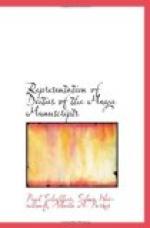God D is not connected with the grim powers of destruction; he never appears with death symbols. In Dr. 5c and 9a he wears the snail on his head. He seems, therefore, like god A to be connected with birth. In Dr. 8c he is connected with god C, and this is quite appropriate, if we look upon these gods as heavenly bodies. The aged face, the sunken, toothless mouth are his distinguishing marks. In the Madrid manuscript, where god D occurs with special frequency, his chief characteristic, by which he is always easily recognized, is the single tooth in his under-jaw (see Fig. 19), compare too Dr. 8c, where the solitary tooth is also to be seen. In Dr. 9a (1st figure) the god holds in his hand a kind of sprinkler with the rattles of the rattlesnake, as Landa (Cap. 26) describes the god in connection with the rite of infant baptism (see also Cort. 26, Tro. 7*a and 13*c)
A very remarkable passage is Tro. 15*; there a figure is pictured carving with a hatchet a head, which it holds in its hand. Above it are four hieroglyphs. The first shows a hatchet and the moon; the second probably represents simply a head, while the third and fourth are those of god D, the moon-god. This passage, the meaning of which is unfortunately still obscure seems to contain a definite explanation of god D.
J. Walter Fewkes has made god D the subject of a special, very detailed monograph (The God “D” in the Codex Cortesianus, Washington, 1895) in which he has treated also of gods B and G, whom he considers allied to D. He believes D to be the god Itzamna, as do also Foerstemann, Cyrus Thomas and Seler, and sees sun-gods in all three of these deities. Whether god D is to be separated from G and B as an independent deity, Fewkes thinks is doubtful. Brinton again holds that god D is Kukulcan. These different opinions show, at all events, on what uncertain grounds such attempts at interpretation stand, and that it is best to be satisfied with designating the deities by letters and collecting material for their purely descriptive designation.
According to Foerstemann the calendar day devoted to D is Ahau.
E. The Maize-God.
[Illustration: Figs. 21-27]
This god bears on his head the Kan-sign and above it the ear of maize with leaves (Fig. 23); compare Dr. 9b (left figure), 11b, 12a, etc. The hieroglyph is definitely determined (Fig. 21). The god is identical with the figures recurring with especial frequency in the Madrid manuscript, the heads of which are prolonged upward and curved backward in a peculiar manner; compare Cort. 15a, 20c, 40 (bottom), Tro. 32*b (Figs. 25-27) and especially the representation in Dr. 50a (Fig. 24), which is very distinct. This head was evolved out of the conventional drawing of the ear of maize; compare the pictures of the maize plant in the Codex Tro., p. 29b (Fig. 22) with the head ornament of the god in Dr. 9b (Fig. 23), 9a, 12a; what was originally a head ornament finally passed




